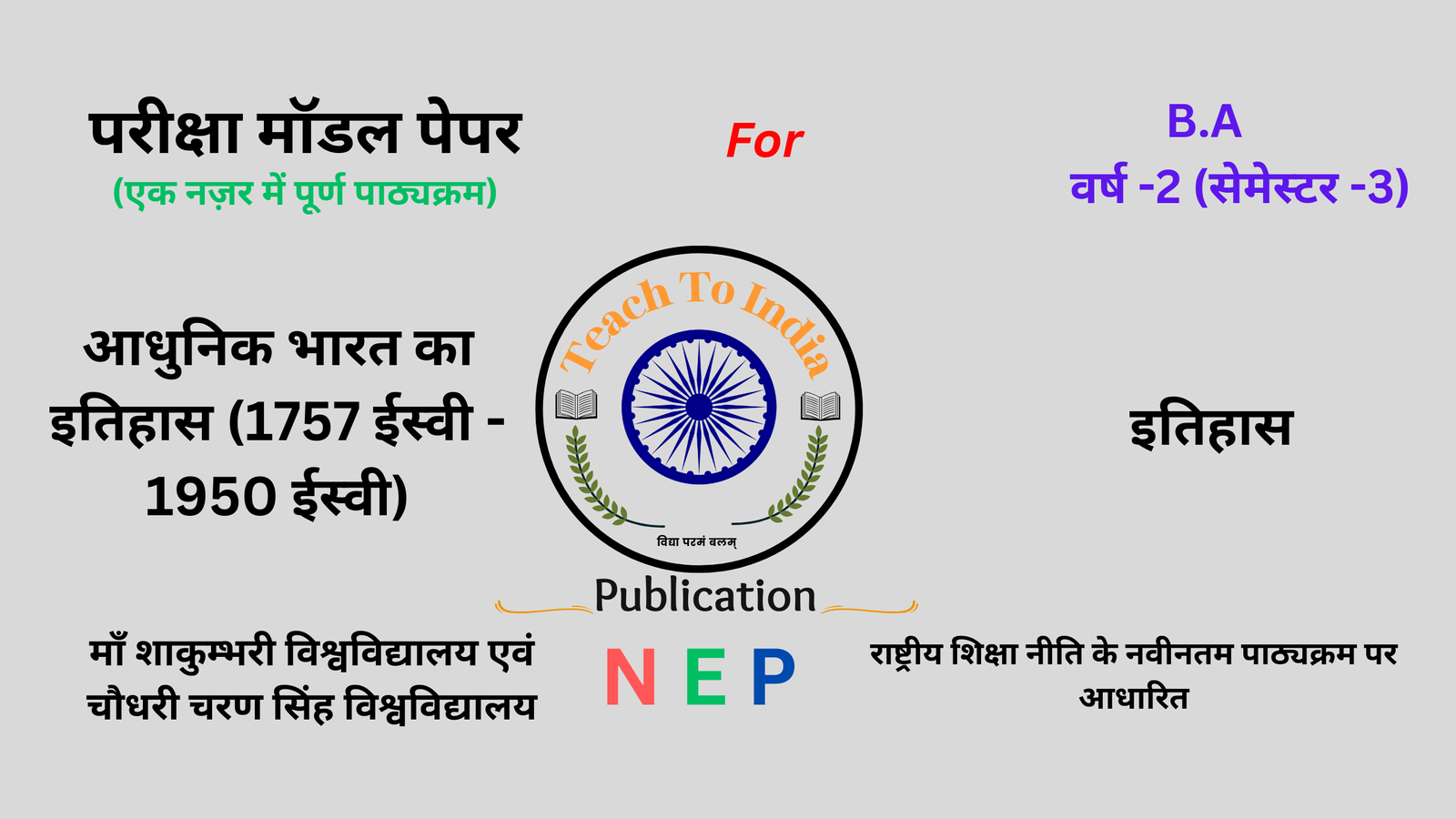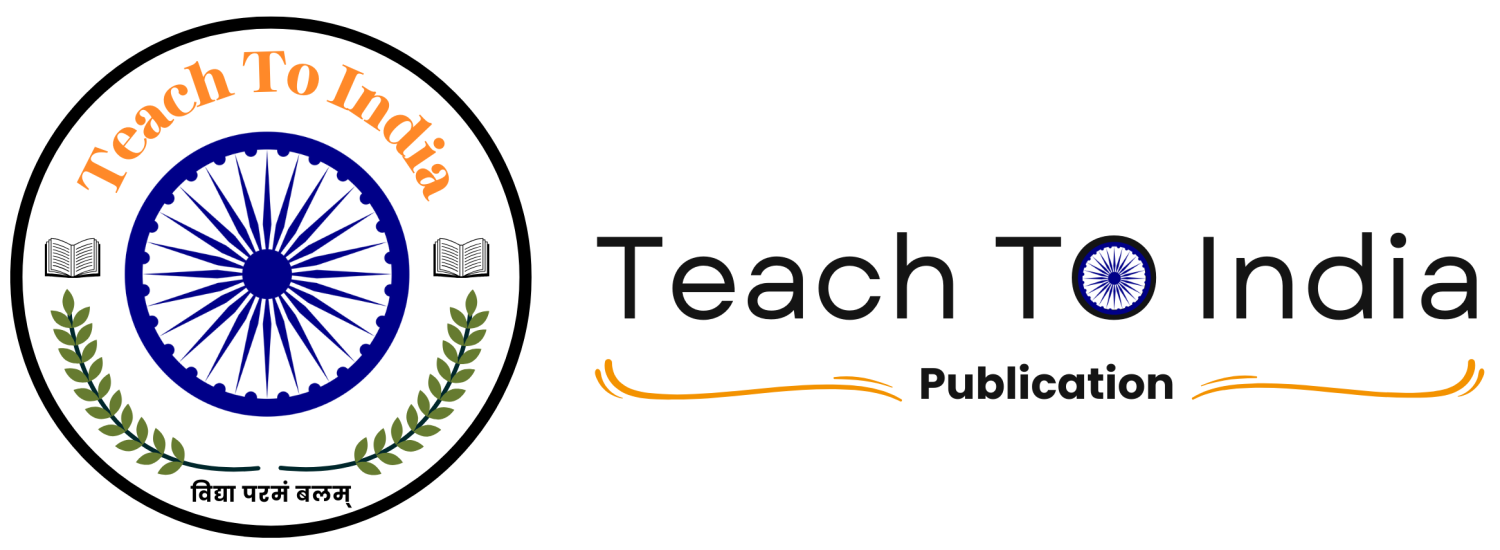आधुनिक भारत का इतिहास (1757 ईस्वी - 1950 ईस्वी) (सेमेस्टर -3)
- Description
- Curriculum
- Reviews

Teach To India प्रकाशन
आधुनिक भारत का इतिहास (1757 ईस्वी – 1950 ईस्वी)
-
यह मॉडल पेपर यह सुनिश्चित करता है कि सभी संभावित प्रश्न जो परीक्षा में आ सकते हैं, वे यूनिट में पूरी तरह से शामिल हैं, चाहे वे सीधे हों या अप्रत्यक्ष रूप से।
-
इसे अनुभवी प्रोफेसरों द्वारा बहुत सावधानी से तैयार किया गया है, जिन्हें परीक्षा मॉडल पेपर बनाने का व्यापक अनुभव है।
-
इस पेपर में विश्वविद्यालय द्वारा निर्धारित पाठ्यक्रम के आधार पर सभी मुख्य प्रश्न शामिल हैं।
-
400 से अधिक प्रश्न और उत्तरों के साथ, यह मॉडल पेपर विषय का पूरा पाठ्यक्रम कवर करता है।
-
प्रत्येक यूनिट में दीर्घ उत्तरीय ,लघु उत्तरीय और अति लघु उत्तरीय वाले प्रश्न शामिल हैं ताकि छात्रों को गहन समझ प्राप्त हो सके।
-
हमारे प्रश्न इस तरह तैयार किए गए हैं कि प्रत्येक यूनिट को कम से कम और अच्छी तरह चुने हुए प्रश्नों से कवर किया जा सके।
-
अनिवार्य आंतरिक परीक्षा के लिए हम 200 एक पंक्ति के प्रश्न-उत्तर प्रदान कर रहे हैं, जो प्रत्येक यूनिट को समान रूप से कवर करते हैं।
-
इस मॉडल पेपर में मॉक प्रश्नपत्र / पिछले साल के प्रश्नपत्र भी हल के साथ दिए गए हैं, जिससे छात्रों को परीक्षा के प्रश्नों की गहराई और विस्तार को समझने में मदद मिलती है।
|
Programme /Class: Diploma |
Year: Second |
Semester: Third |
||
|
Subject: History |
||||
|
Course Title: History of Modern India (1757 A.D – 1950 A.D) |
||||
|
Course outcomes: This paper is designed to cover the era Indian history witnesses the transfer of power From Mughals, other provincial important dynasties to East India Company. It covers the study of Indian resistance at various levels and finally culminates in the First War of Independence. This is an important era of Indian History, as it witnesses the rise of indigenous powers like Marathas and Sikh State, along with new regional identities. This paper covers also the colonial land revenue system and Indian Renaissance. The course is designed to provide an overview of modern Indian political history and key concepts of the modern constitutional development to the students. The paper covers the history of British educational and agricultural policy with their impact over India. This paper also covers the development of communalism in India and mergers of Princely states after Independence,
|
||||
|
Credits: 6 |
Core Compulsory/Elective |
|||
|
Max. Marks: 25+75 |
Min. Passing Marks: 8+25 |
|||
|
Unit |
Topics |
|||
|
I |
Arrival of European Companies: Rivalry for Control, Ascendancy of British East India Company: Plassey and Buxar and its impact.
|
|||
|
II |
Territorial Expansion of East India Company: 1770-1856
|
|||
|
III |
Rise of Punjab under Ranjeetsingh: conquests and administration. Rise of* Hyderabad and Mysore in 18′ century.
|
|||
|
IV |
Land Revenue system during colonial period: permanent settlement. Raiyatwari and Mahalwari system, Indian Renaissance: Reform and revivals.
|
|||
|
V |
Transfer of Power: From Company to Crown, Lord Lytton and Lord Ripon. Lord Curzon and Partition of Bengal.
|
|||
|
VI |
Commercialisation of Agriculture and its Impact on Indian, Development of Railway and its Impact.
|
|||
|
VII |
Development of Education in Colonial India. Morley-Minto reforms, Govt. of India Act 1919 and 1935.
|
|||
|
VIII |
Mergers of Princely states after Independence, and Role of Sardar Vallabh Bhai Patel.
|
|||
-
1यूनिट-1: आधुनिक भारत का इतिहास (1757 ईस्वी - 1950 ईस्वी)
-
2यूनिट-2: आधुनिक भारत का इतिहास (1757 ईस्वी - 1950 ईस्वी)
-
3यूनिट-3: आधुनिक भारत का इतिहास (1757 ईस्वी - 1950 ईस्वी)
-
4यूनिट-4: आधुनिक भारत का इतिहास (1757 ईस्वी - 1950 ईस्वी)
-
5यूनिट-5: आधुनिक भारत का इतिहास (1757 ईस्वी - 1950 ईस्वी)
-
6यूनिट-6: आधुनिक भारत का इतिहास (1757 ईस्वी - 1950 ईस्वी)
-
7यूनिट-7: आधुनिक भारत का इतिहास (1757 ईस्वी - 1950 ईस्वी)
-
8यूनिट-8: आधुनिक भारत का इतिहास (1757 ईस्वी - 1950 ईस्वी)







